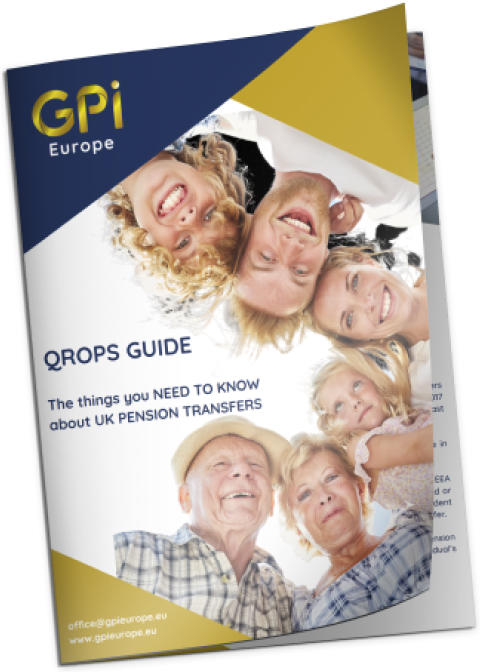We will call you back at +44 876 765 48 within 2 hours up till 7pm or next morning from 9:30am
Determine your current financial situation
Identify and develop financial goals
Creating a step-by-step plan to achieve them
Track your progress and make adjustments
Understanding QROPS & SIPP. Finding the right pensions scheme for you.
Rising interest rates mean higher gilt rates which, in turn, means lower pension transfer values (CETV’s).
If you hold a UK pension and are now living in Europe, transferring your UK pension to a more tax efficient vehicle such as a SIPP or ROPS is one option that you must consider.
In 2015 the Pensions Regulator (TPR) and Department for Work & Pensions (DWP) published a joint statement on 5th July, and confirmed that the DWP is currently reviewing these Occupational and Personal Pension Schemes (Conditions for Transfers) Regulations, ( Dealing with transfer requests | The Pensions Regulator ).
This followed the original pension changes announced in 2006 which only applied to those moving away from the UK to live and/or work abroad.
Until 2006 if you lived in the UK with a UK pension, and moved abroad, your options to ‘port’ that scheme into an expat pension was virtually impossible. Typically, if you became an expatriate, your pension schemes would have been frozen, meaning no more contributions were possible.
In April 2006, the UK Government introduced new legislation, to help British expats have more control over their pensions when moving overseas. This legislation introduced an expat pension option known as QROPS, or Qualifying Recognised Overseas Pension Scheme now simply called ROPS.
Your UK pension is likely to fall into one of two types:
- Defined contribution scheme – a pension pot based on how much is paid in
- Defined benefit scheme – which provides a guaranteed pension on retirement
So what does this mean your options are:
1) Leave your pension in the UK
If you are looking for a low risk, guaranteed lifetime income and your existing pension will provide this, then you may be better staying with your existing scheme. It may also be the case that a UK Pension Transfer would see a substantial reduction in the value of your benefits.
2) Take Control Of Your UK Pension by transferring to a SIPP or ROPS
If you want greater control over your investments, protecting the current transfer value of your scheme for yourself and your beneficiaries, taking the current opportunity of high transfer value, a UK pension transfer away from your existing scheme could be the right choice for you.
What is a SIPP?
A Self-Invested Personal-Pension (SIPP) is a straightforward UK based pension that, with the help of your financial adviser, allows you to take greater control of your pension fund. Transferring your UK pension to a SIPP can provide increased investment choice and greater flexibility over income options at retirement, you can tailor a retirement plan to suit your individual needs. It is estimated that one million people hold a SIPP, and as platform efficiencies have allowed lower cost solutions to be reached by more investors, SIPPs are becoming more attractive and increasingly popular for those looking to transfer their existing UK pension to make the most out of their retirement provision.
What is a ROPS?
A Recognised Overseas Pension Scheme is an international pension plan, recognised by HMRC. As an international plan, it can benefit from local taxation and adapt to your changing circumstances – particularly of use for those retiring offshore where residency and taxation are a key component of long-term income planning. When you transfer your UK pension into a ROPS, it is no longer subject to the ever-changing UK pension legislation, can benefit from improved tax efficiency for those residents outside of the UK for at least ten years, and does not carry a pension lifetime allowance when tested on transfer from the UK.
A ROPS has to meet certain criteria, it must be established outside of the UK, recognised for tax purposes in the country where it’s located and regulated in the country where it’s established (this must be an EEA country to avoid the 25% tax charged imposed in 2017).
ROPS v SIPPs
There are two distinct advantages of a ROPS scheme over a SIPP scheme and they are:
- The Life Time Allowance (LTA) rules for a ROPS is far more beneficial and flexible
- ROPS pay their drawdown pensions gross so you benefit from deferred taxation
These advantages mainly apply to higher transfer values which will cross the LTA limits at some stage. A transfer from a registered pension scheme to a ROPS is a benefit crystallisation event (BCE 8) therefore on completion of the transfer we will test the transfer value (before a potential overseas transfer charge) against the current Lifetime Allowance for the year. With any Lifetime allowance test should it exceed 100% of your available Lifetime Allowance then tax charges will apply.
Here are the main advantages of transferring to either scheme:
- Tax-free lump sum of up to 30%
- The ability to have your income taxed in your country of residence, which may have lower tax rates
- Potential to pay no Income Tax charge in the event of death
- Access to a large range of global investment funds
- Ability to consolidate multiple historic pensions
- No charge on lifetime allowance; the amount you can save tax-free into your pension
- The ability to leave your pension to a beneficiary of your choice
- Access to pension benefits from age 55 without penalty
- Payments in any major currency, thereby eliminating the impact of exchange rates
WORKING WITH GPI
Dealing with expat pensions can be a complex process, especially if you are trying to relocate your career, family and life overseas. Our team of financial planners have many years of experience in dealing with expat pensions, tax and retirement.
To discuss your plans in more detail please contact us!

Thank you for your appeal!
We will call you back in the next 2 hours.
Face to face financial advice online
Feel free to arrange a free online consultation with our financial adviser, in the comfort of your own home or place of work.
Frequently Asked Questions
How does pension fund work?
A pension is a retirement fund that an individual, employer or both, can contribute into. The funds saved are then invested over the long-term to create a ‘pot’ which can be used as income to fund your retirement. There are a range of pension options available, depending on how you decide to take your income when it comes to retirement.
What is Defined Benefit scheme?
A Defined Benefit scheme is an occupational pension scheme provided by an employer for its employees, where the benefits at retirement are defined as a proportion of salary at, or close to, retirement.
Defined Benefit schemes are also often referred to as Final Salary Schemes.
As required by the Pensions Freedoms Act April 6th 2015, any Defined Benefit Scheme over £30,000 must take additional FCA advice from a Pension Transfer Specialist.
The accrued pension is a reflection of years worked and your final salary before leaving and the Cash Equivalent Transfer Value (CETV) is based upon Gilt rates which are presently at a record low thus producing such a high cash value considering the length of service.
Moving this and other schemes to ROPS (recognised overseas pension scheme) offers fairer and more flexible choices, the main one being that your spouse and children (regardless of age) continue to receive 100% of your pension as well as the residual pension “pot“.
What is Defined Contribution scheme?
The contributions into a Defined Contribution scheme are used to establish a pension fund. The size of the fund is determined by the amount of contributions (by both the individual and the employer), the charges deducted by the pension provider and the investment returns achieved over the term to retirement.
Defined Contribution schemes are often referred to as Money Purchase Schemes.
As these schemes are invested in Stocks and Shares, most clients have no current advisor or assistance with these plans!
What happens to my pension if I move abroad?
If you leave the UK permanently, transferring your pension into an international pension scheme may be your best option. In these cases, a QROPs may be recommended to help you avoid some restrictions associated with living abroad whilst holding a UK pension.
What are the issues to consider before transferring?
The existence of any guarantees within a current Defined Benefit Pension will be lost upon transfer. These will be highlighted in an independent report and in addition whether there are exit penalties upon transferring.
What tax is paid on a QROPS pension income?
With a UK pension scheme when income is taken it is taxed at up to 45% and this may be deducted at source even if the member is non-UK resident. Although it is possible for the income to be paid gross, the member will have to prove to HMRC that they are paying tax elsewhere, the reason being that HMRC want to ensure that tax is being paid somewhere.
Once the pension scheme is transferred to a QROPS it may be possible for the income to be paid gross depending on the local tax rate or the existence of a double taxation agreement.
In some circumstances there may be no tax on pension income depending on the country of residence of the member and the jurisdiction in which the QROPS is held.
What Tax is paid on death within a QROPS scheme?
At present there is a tax on death once a UK pension scheme member has begun to take benefits. This is currently set at 55% and means that beneficiaries will only receive 45% of the remaining fund.
This tax replaced the need to buy an annuity once the age of 75 was reached.
With a QROPS, after five years non-UK residency, tax on death will no longer apply and beneciaries may receive 100% of the remaining fund.
Are QROPS included in your estate for Inheritance Tax?
QROPS are exempt from Inheritance Tax (IHT) in the same way as UK pension schemes.

Thank you!
Our First steps in QROPS guide is waiting for you at pochta@mail.com
QROPS guide
Please leave your contact details to receive our QROPS guide.